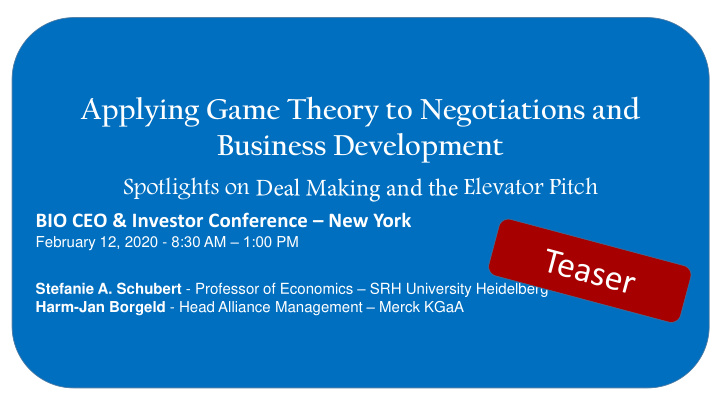



Applying Game Theory to Negotiations and Business Development Spotlights on Deal Making and the Elevator Pitch BIO CEO & Investor Conference – New York February 12 , 2020 - 8: 30 AM – 1 : 0 0 PM Stefanie A. Schubert - Professor of Economics – SRH University Heidelberg Harm-Jan Borgeld - Head Alliance Management – Merck KGaA
Objective of the Workshop This workshop covers … Methods: By participating in this workshop, you will learn how to: • Applied learnings from • advanced business Improve your decision making by acquiring a systematic framework development practice for decision making using Game Theory . • • Improve your elevator pitch to enhance your negotiation outcome and Real-life pharma/biotech cases enhance the impact on your stakeholders. • • Achieve better negotiation results by applying advanced negotiation Game Theory • techniques . In-class exercises The attendees will leave the workshop with a Game Theory, Elevator Pitch, Negotiation and toolkit specifically designed for Senior Management. 2
Game Theory as the Cornerstone GA GAME TH THEORY STRATEGIC DECISION MAKING ELEVATOR PITCH NEGOTIATIONS 3
Game Theory Strategic Decision Making Is the science of strategic decision making Offers a useful framework for assessing the options and analyzing decisions Unveils your partner’s choices Enables you to influence the outcome Look ahead and reason back to achieve the desired outcome 4
How to make a Great Elevator Pitch? How game theory shapes your perspective: predict your counterpart/stakeholder’s preferred outcome. Create an engaging opening sentence Tailored body language: eye contact use meaningful gestures smile Focus on only one core message Create multiple versions 15/30/60 seconds Follow-up 5 5 5
Who does well and who could do better? 6
Look at All Options at the Same Time Harvard Business Review: examine one option at a time (sequential DM) or review all our DM options together People were on average 22% more likely to chose the best option when they viewed all options together rather then one at a time Websites – companies tend to show one product at a time…… To make better choices look at all your options at the same time Basu and Savani, HBR, June 28, 2017 7
Case Study: John and the Phase III Study Design #1 Case studies John his first meeting in the afternoon was with Carla Christiansen, Head of Clinical Development. Carla would like to receive John’s approval for the Phase III study design for the company’s lead oncology compound, Diatuzumab. The company had conducted a successful Phase II study and for both active arms, the high dose (40 mg/kg) and the low dose (5 mg/kg), the endpoint was met. Carla has been impressed by the data and makes her case that Diamond Pharmaceuticals should go forward with a Phase III study with a high dose arm. The efficacy of a high dose is impressive. Ovarian cancer is a difficult cancer type to treat, but Diatuzumab might be able to overcome the hurdle where many other compounds failed. John asks Carla to show the slide with the efficacy data. On first sight, the high dose was the best option but the low dose was not far off. ………………... ..tbc Should John decide for either the high-dose or low-dose arm? 8
Case Study: John and the Phase III Study Design #2 John vs Kylie Kylie John’s payoffs : high dose low dose If he decides for … - Kylie decides for…: High - high: 50% of $4B-$1B costs = 1 high dose 1,1 2,0.5 High - low: 75% of $4B-$1B costs = 2 John Low - high: 25% of $4B-$0.5B costs = 0.5 0.5,2 1.5,1.5 low dose Low - low: 50% of $4B-$0.5B costs = 1.5 9
Case Study: John and the Phase III Study Design #3 high (2, 2 ) dose Kylie John high dose vs Kylie low dose (2, 0.5 ) John high (0.5, 2 ) What if Kylie is informed dose Kylie about John’s decision? low dose Solving the game: low Look ahead and reason back dose (1.5, 1.5 ) 10
Multiple Equivalent Simultaneous Offers (MESO) Negotiations Useful in collecting Use MESOs if the information from counterparty .. the partner is not willing to Be creative and share information provide multiple options that have does not reveal the same value priorities This signals cooperation 11
Group Negotiations In-Class Exercise: Diamond Pharmaceuticals Wants to Buy Safire Biotech You will have 25 minutes to agree on the following: Location of the HQ, either San Francisco or Guangzhou Price that Diamond (Market Cap: USD 40B) is going to pay for Safire (Market Cap: USD 26B) Two persons will represent Diamond One person has to negotiate San Francisco as HQ One person has to negotiate the best price Two persons will represent Safire One person has to negotiate Guangzhou as HQ One person has to negotiate the best price 12
Course Facilitators: Stefanie Schubert & Harm-Jan Borgeld Professor Stefanie Schubert, PhD CA-AM Professor of Economics at SRH University Heidelberg. Previous position: Assistant Professor of Organization Theory Expertise: strategic decision making, managerial economics, and Management at WHU (Vallendar/Düsseldorf) strategic alliances/networks. Consultant for strategic management lllllllllllllllllllllllllllllll We are looking forward to seeing you in Harm-Jan Borgeld, PhD MBA CSAP Head of Alliance Management at Merck Healthcare KGaA, Received his MBA: RSM, NL/Haas Business School, USA; Darmstadt Germany. Responsible for the Commercial, Ph.D: Faculty of Medicine, University of Nagoya, JP Development, Research, and selected Regional Alliances. 13
Recommend
More recommend